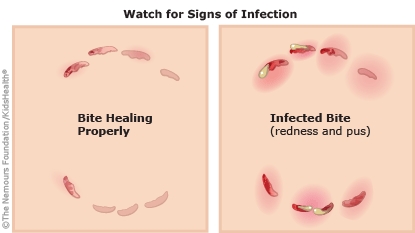Human bites usually aren't serious, but they should be treated early to prevent infection. The health care provider examined the bite for signs of nerve damage, tendon damage, and infection, and then cleaned the bite to prevent infection. Your child also might have had an X-ray or blood test. If infection was a concern, the health care provider may have prescribed antibiotics.
Most human bites do not need repair. If this one did, the health care provider might have closed the wound with stitches. Sometimes after a bite, children need vaccination against certain infections, including tetanus and some viruses. The health care provider gave any vaccines that your child needed.


Follow the package directions for how much to give and how often. If you don't know the recommended dose or your child is younger than 2 years old, call the health care provider to find out what to use and how much to give. Do not give aspirin to your child or teen as it has been linked to a rare but serious illness called Reye syndrome.



Why is biting common among kids? There are many reasons for bites among children. Babies and toddlers might bite to get a reaction or to express how they feel when they can't use words. Children might bite their own hands during thumb-sucking or nail-biting. Biting can also happen during rough play. In older kids, accidental bites may happen during a fistfight. When a mouth is punched, the teeth can break the skin over the knuckle, causing a bite wound.
Why do human bites need to be treated quickly after they happen? Human bites contain high levels of germs and are likely to become infected if they break the skin. (Luckily, most bites during childhood play do not break the skin.) Bites on the hands or face or near joints are especially worrisome because infection in these areas can be serious. Sometimes, human bites can damage nerves or tendons.